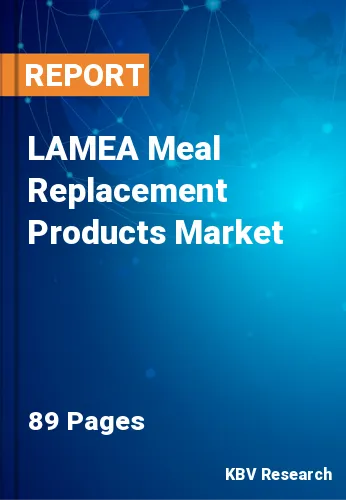The LAMEA Meal Replacement Products Market is expected to grow at a CAGR of 7.8% during 2019-2025. The Brazil market dominated the LAMEA Meal Replacement Products Market by Country 2018, thereby, growing at a CAGR of 6.9 % during the forecast period.
The per capita disposable income measures the willingness of a person to purchase goods or services. As disposable income increases, customers are more likely to increase their purchases of discretionary items, such as meal replacement products. Nevertheless, the industry is competing against more costly weight loss products, including pills and diet food delivery services, and in times of tight spending, it is attracting some weight-conscious consumers. In the coming years, disposable income is expected to rise, creating a potential opportunity for the industry.
With e-commerce rising, manufacturers find it easy to reach out at minimal cost to a wider audience. This drives companies to create their own websites and create contracts to drive online sales to major e-commerce platforms. In fact, virtual word-of-the-mouth marketing is seeing significant growth due to various fitness blogs and vlogs.
What’s more, manufacturers are making major investments in web advertisements and digital marketing strategies for expanding their customer base and encouraging them to purchase their products. This is expected to contribute across online distribution channels to the rapid sales of meal replacement products.
Meal replacement products should do not have to completely substitute all meals when it comes to nutrition. Also, there's no need for them to replace the consumption of whole foods, particularly fruits and vegetables, as they are unique sources of antioxidants and phytochemicals and are available in a form where most nutrients are bioavailable.
A majority of meal replacement products are labeled as weight management aids, meal replacements, or power boosters when it comes to marketing. Meal replacement items aimed at weight loss break away from misleading nutritional claims such as "low calorie" or "reduced sugar", and instead emphasize the healthy, functional advantages of meal replacement.
Increased rate of diabetes, obesity, and cardiovascular diseases among others is expected to raise consumer awareness about weight loss and weight management diets, which will drive demand in turn. Meal replacement products contain 200 to 400 calories along with fiber, protein, and other essential nutrients, making them an all-inclusive and convenient food choice. This aspect is expected to drive the growth of the market further.
Free Valuable Insights: Meal Replacement Products Market in LAMEA is expected to register a CAGR of 7.8% during the forecast period (2019-2025)
Based on Product, the market is segmented into Powder, Ready to Drink and Protein Bar. Based on Distribution Channel, the market is segmented into Online and Offline. The report also covers geographical segmentation of Meal Replacement Products market. The countries included in the report are Brazil, Argentina, UAE, Saudi Arabia, South Africa, Nigeria and Rest of LAMEA.
Key companies profiled in the report include Abbott Laboratories (Abbott Nutrition), Glanbia PLC, General Mills, Inc., Bob’s Red Mill Natural Foods, Inc., Unilever PLC, Nestle S.A., Herbalife International Inc., Kellogg Company, The Kraft Heinz Company and Blue Diamond Growers, Inc.
Market Segmentation:
By Product
By Distribution Channel
By Country
Companies Profiled
Our team of dedicated experts can provide you with attractive expansion opportunities for your business.

